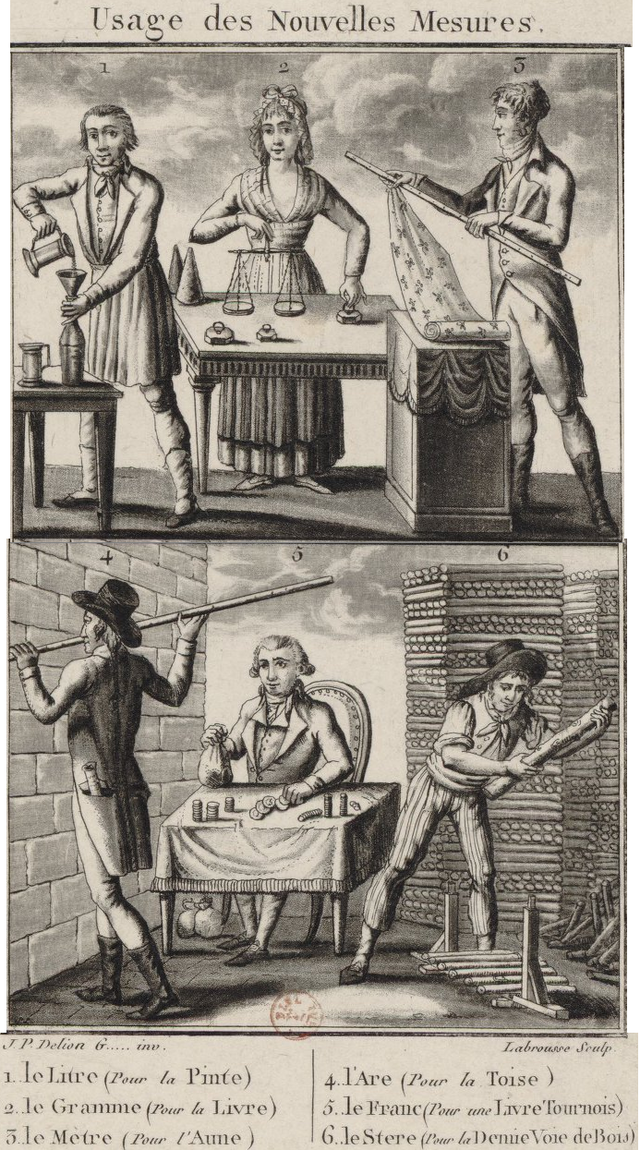热门问题
时间线
聊天
视角
传统法国计量单位
来自维基百科,自由的百科全书
Remove ads
传统法国计量单位,或旧制度下的法国计量单位,即公制化之前的法国计量单位。该系统是在加洛林文艺复兴的查理曼时期建立的,参考了拜占庭帝国和古罗马的计量标准。

在查理曼去世后,加洛林帝国四分五裂,计量单位也在各地产生各种变化。一些单位的一致性较好,如“国王的脚”或“王尺”(法语:pied du Roi)在长达千年的时间里几乎保持不变。然而,商业中重要的单位如“法肘”(aune,用于量布料)和“法磅”(livre,用于衡量重量及表示货币,见里弗尔)在各地则差异很大。例如,“法里”(lieue)在博斯为3.268公里,在普罗旺斯则为5.849公里。尽管“王尺”因其卓越的一致性被学者使用,但许多商人选择使用他们自己的测量设备,这为欺诈提供了空间,且阻碍了商业和工业的发展[1]。
法国的传统计量单位和英制单位较为类似,但不同的是,英国《大宪章》颁布了“统一全国计量单位”的法令,而旧制度下的法国一直未能统一计量单位[1]。到了18世纪,法国的计量单位种类繁多,数量达七八百种,名称相同的计量单位所代表的值因城镇而异,甚至因行业而异。据估计,在大革命前夕,法国实质上有约20万种不同的计量单位[2]。
为此,法国大革命后制定了公制,然而变为公制的改革在法国遇到了很大的阻力,因此不得不又制定了将传统计量单位公制化的惯用制,惯用制在法国一直使用到1840年。

以下各单位的定义使用巴黎的标准,在此情况下,“法尺”和“王尺”可以通用,旧制度下其他地区的相关定义各有不同,有时差别相当显著。
Remove ads
长度


中世纪的王家长度单位基于法寻(toise,音译为土瓦兹,类似英寻),尤其是写字台法寻(toise de l'Écritoire),它是一个人伸出的手臂指尖之间的距离,由查理曼大帝于790年引入[3]。法寻等于6法尺(pied,源自脚的长度,类似英尺),最早由大沙特莱上的一根铁条(约1.960米长)定义。到1668年,大沙特莱上的铁条出现了明显的变形,因此制定了新的铁条取而代之。新的标准被命名为沙特莱法寻(toise du Châtelet),相比原值短了约11毫米,为1.949米。
尽管法寻、法尺、法寸(pouce,源于大拇指指节到指尖的长度,类似英寸)在革命前的法国大部分地区都相当一致,但某些地区也有各种不同的法寻。其他计量单位如法肘(aune,一肘长度)、杆(perche)、阿庞(arpent)和法里(lieue)也有许多变体,尤其是用于测量布料的法肘[4]。
1799年12月10日的法律规定,十进制的“米”精确地等于443.296法分(ligne,或直译为“线”)[5]。因此法国的“王尺”是9000/27 706米(约0.3248米)[6]。而在魁北克,法国单位转换关系是1法尺=12.789英寸[7],这使得魁北克的法尺比法国本土的略小(约百万分之四)。
Remove ads
面积
Remove ads
体积
Remove ads

Remove ads
重量
| 阿布维尔 | 93–94 |
| 阿维尼翁 | 83 |
| 博凯尔 | 95 |
| 波尔多 | 100 |
| 布雷斯地区布尔格 | 96 |
| 敦刻尔克 | 87 |
| 里尔 | 87–88 |
| 里昂 | 87 |
| 马赛 | 81 |
| 蒙彼利埃 | 83 |
| 南锡 | 94–95 |
| 南特 | 101–102 |
| 拉罗谢尔 | 101–102 |
| 鲁昂(poids de vicomté ) | 103 |
| 斯特拉斯堡(petit poids) | 96 |
| 图卢兹 | 84 |
法国的重量系统来源于查理曼的系统,为12盎司为1磅(里弗尔)。1076年至1093年间,国王腓力一世制定了用于铸造硬币的马克重量系统“poids de marc”,每8盎司为1马克[12]。
约翰二世制定了新的计量标准,等同于2马克(16盎司)的“livre actuelle”(“现行”磅,或马克磅)出现了[13]。原本12盎司的查理曼磅被称为“livre esterlin”(“真”磅)以区分[14]。
盎司的分割单位在药衡制(用于医学)和金衡制(用于贵金属)中有不同的名称,但比率是相同的:1盎司分为8打兰或格罗斯;1打兰或格罗斯分为3吩或但尼尔,1吩或但尼尔等于24格令[15]。这使得从重量上,1磅等于384但尼尔,与法国旧货币系统中1里弗尔等于240但尼尔不同[16]。
约翰二世的标准至今保存在法国国立工艺学院中,该学院还拥有一套15世纪至今仍在使用的物理标准,即所谓的查理曼堆(pile de Charlemagne)[17][18]。查理曼堆定义了50马克(或400盎司,25“现行”磅,331⁄3“真”磅)[12][19]。它原本保存在王宫中[20],1540年,弗朗索瓦一世国王将它转移到货币法院,保存在一个带三把锁的柜子里,柜子的钥匙分别由院长、一名顾问和一名书记保管[20]。
在巴黎的查理曼堆由十三个杯子层层嵌套组成,(类似俄罗斯套娃)[19][21][22],从重到轻,依次标称20马克、14马克、8马克、4马克、2马克、1马克、4盎司、2盎司、1盎司、4格罗斯、2格罗斯、1格罗斯、1格罗斯,总计50马克。1马克的杯子被称为“空心”马克,最小的七个杯子放在一起被称为“实心”马克[19][21][23][22]。
然而,实际重量与标称并不一致,“空心”马克的重量和“实心”马克不同,也与从整堆重量中平均计算得到的值不同[19][23]。最终,整堆重量(12.2376kg[24])被用来定义50个巴黎马克的重量[19]。经四舍五入后,巴黎马克等于244.753g。
因此,巴黎盎司为30.594g。巴黎打兰或格罗斯为3.824g,巴黎吩或但尼尔为1.274g,巴黎格令为0.053g[25][26]。“现行”巴黎磅(16盎司,2马克)为489.506g,“真”巴黎磅(12盎司)为367.129g[15][27]。
然而,实际情况远非如此简单[28]。除了巴黎标准外,其他省份、城市甚至行会都有自己的标准,有时还将“真”磅和“现行”磅混为一谈[28]。举例来说:马赛磅是399.6克,蒙彼利埃磅是394.9克,土伦磅是465.5克,图卢兹磅是413.2克;所有细分单位的重量也相应地具有不同的值[29]。利摩日马克为240.929克,图尔马克为237.869克,特鲁瓦马克为250.050克[30]。
此外,还有一些与“真”磅和“现行”磅不同的磅,例如1磅等于14、18或20盎司,这使得情况更为混乱[31]。普罗旺斯和朗格多克使用表重系统“poids de table ”、里昂有丝重系统“poids de soie ”、还有其他各省、各城镇重量系统。这些系统中的磅相当于巴黎马克系统[32][33][34][10]中的13至15盎司[10],这导致人们错误地认为这些地方的磅是由13、14或15盎司组成的[35][33][10],此外鲁昂还有一个子爵领重量系统“poids de vicomté”[10]。
Remove ads
参见
- Adler, Ken. The Measure of all Things—The Seven-Year-Odyssey that Transformed the World. London: Abacus. 2002. ISBN 0349115079.
- Blome, Walter Henry; Stocking, Charles Howard; Watts, Edward Cecil. Fundamentals of Pharmacy: Theoretical and Practical. Lea & Febiger. 1939.
- Crease, Robert P. France: 'Realities of life and labour'. World in the Balance: The Historic Quest for an Absolute System of Measurement. W. W. Norton & Company. 2011. ISBN 9780393082043.
- Darcy-Bertuletti, Yvette. Tableau des mesures les plus courantes en usage dans le pays beaunois [Table of the most widely used measurents in the Beaune locality] (PDF). Ville de Beaune. 2005 [2011-02-25]. (原始内容存档 (PDF)于2021-04-11) (法语).
- Daumas, Maurice (编). A History of Technology & Invention: The expansion of mechanization, 1725–1860
 2. Crown Publishers. 1970. ISBN 9780517520376.
2. Crown Publishers. 1970. ISBN 9780517520376. - Débarbat, Suzanne. Fixation de la longueur définitive du mètre [Establishing the definitive metre]. Ministère de la culture et de la communication (French ministry of culture and communications). [2011-03-01]. (原始内容存档于2019-12-13) (法语).
- Doursther, Horace. Pile de Charlemagne. Dictionnaire universel des poids et mesures anciens et modernes. Brussels: l ́académie. 1840.
- Du Mersan. Livre (poids et monnaie). Encyclopédie des gens du monde. Paris: Treuttel et Würtz. 1833. 互联网档案馆收藏的《Encyclopédie des gens du monde》
- Expilly, Jean-Joseph. Poids. Dictionnaire géographique, historique et politique des Gaules et de la France. Amsterdam: Desaint et Saillant. 1768. 互联网档案馆收藏的《Dictionnaire géographique, historique et politique des Gaules et de la France》
- Février, Denis. Un historique du mètre. Ministère de l'Economie, des Finances et de l'Industrie. [2011-03-10]. (原始内容存档于2011-02-28) (法语).
- Garnier, Joseph. Livre (poids). Guillaumin, M. (编). Encyclopédie du commerçant: Dictionnaire du commerce et des marchandises 2. Paris: Guillaumin et Cie. 1841a. 互联网档案馆收藏的《Encyclopédie du commerçant》
- Garnier, Joseph. Marc (poids). Guillaumin, M. (编). Encyclopédie du commerçant: Dictionnaire du commerce et des marchandises 2. Paris: Guillaumin et Cie. 1841b. 互联网档案馆收藏的《Encyclopédie du commerçant》
- Guilhiermoz, P. Note sure les poids do Moyen Age. Bibliothèque de l'École des chartes (Librairie Droz). 1906, 67: 402–450. JSTOR 43004870. doi:10.3406/bec.1906.460058.
- Harkness, William. On the Progress of Science as Exemplified in the Art of Weighing and Measuring. Judd & Detweiler. 1888.
- Kelly, Patrick. Lyons. The universal cambist, and commercial instructor 1. London: Lackington, Allen, & Co. 1811.
- Mongez, Jean André; de La Métherie, Jean-Claude (编). Suite du rapport fait à l'Institut national des sciences et arts sur le mètre, etc.. Journal de physique, de chemie, d'histoire naturelle et des arts (Paris: Bachelier). 1799, 49.
- Morin, A. Catalogue des collections 4th. Paris: Bourdier. 1864.
- Peuchet, Jacques. Vocabulaire des termes de commerce, banque, manufactures, navigation marchande, finance mercantile et statistique. Paris: Testu. 1801.
- Rowlett, Russ. How Many? A Dictionary of Units of Measurement. Center for Mathematics and Science Education, University of North Carolina at Chapel Hill. [2011-02-28]. (原始内容存档于2012-12-24).
- Sabot, Thierry. Les poids et mesures sous l'Ancien Régime [The weights and measures of the Ancien Régime]. histoire-genealogie. 1 October 2000 [2011-02-10]. (原始内容存档于2010-12-05) (法语).
- Saigey, Jacques Frédéric. Système Français. Traité de métrologie ancienne et moderne: suivi d'un précis de chronologie et des signes numériques. Paris: Hachette. 1834. (互联网档案馆收藏的《Traité de métrologie ancienne et moderne》
- Savary, Jacques; Savary, Philemon Louis. Étalon. Dictionnaire universel de commerce, d'histoire naturelle et des arts et metiers. Geneva: Les heretiers Cramer. 1742.
- Witthöft, Harald. numerical Communication in Intercontinental Trade and Monetary Matters: Coins, Weights, and Measures in China and East Asia in Merchants' Picketbooks and Commercial Guides. Theobald, Ulrich; Cao, Jin (编). Southwest China in a Regional and Global Perspective (c.1600–1911): Metals, Transport, Trade and Society. BRILL. 2018. ISBN 9789004353718.
- Zupko, Ronald Edward. Beginning of Revolution in France. Revolution in Measurement: Western European Weights and Measures Since the Age of Science. American Philosophical Society. 1990. ISBN 9780871691866. ISSN 0065-9738.
Remove ads
参考资料
Wikiwand - on
Seamless Wikipedia browsing. On steroids.
Remove ads
